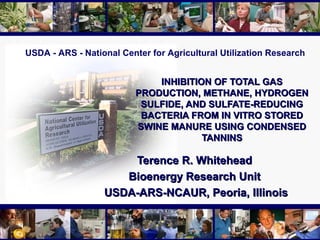
Inhibition Of Total Gas Production, Methane, Hydrogen Sulfide, And Sulfate-Reducing Bacteria From In Vitro Stored Swine Manure Using Condensed Tannin
- 1. USDA - ARS - National Center for Agricultural Utilization Research INHIBITION OF TOTAL GASINHIBITION OF TOTAL GAS PRODUCTION, METHANE, HYDROGENPRODUCTION, METHANE, HYDROGEN SULFIDE, AND SULFATE-REDUCINGSULFIDE, AND SULFATE-REDUCING BACTERIA FROM IN VITRO STOREDBACTERIA FROM IN VITRO STORED SWINE MANURE USING CONDENSEDSWINE MANURE USING CONDENSED TANNINSTANNINS Terence R. WhiteheadTerence R. Whitehead Bioenergy Research UnitBioenergy Research Unit USDA-ARS-NCAUR, Peoria, IllinoisUSDA-ARS-NCAUR, Peoria, Illinois
- 3. Pig House Manure Storage Underground Storage of Swine Manure
- 4. Partial List of Identified Volatile Organic Compounds From Swine Manure 1-Methylethanol Acetic Acid Propanol Propanoic acid 2-Methoxyethanol 2-Methylpropanoic acid 2-Methylpropanol Butanoic acid Butanol Hexanoic acid 3-Methylbutanol 2-Phenylethanol Pentanol p-Cresol 3-OH-butanone 3-Methylindole 3-Octanol p-Ethylphenol 2,3,4-Trithiapentane o-Methoxyphenol
- 5. Additional Emissions Also Which May Play Important Roles From Swine Manure • Ammonia •Hydrogen Sulfide •Methane
- 6. Identification of Bacteria Involved in Manure Breakdown and Odor Production I. Classical Microbiology • Pure culture isolation and identification using habitat simulating media, biochemical techniques and 16S rDNA gene sequence analyses. II. Molecular Ecology (Culture Independent) • Isolate total DNA from fecal and manure samples, determine DNA sequence of isolated 16S rDNA genes, and identify bacteria by comparison with known sequences in GenBank database.
- 8. Miscellaneous Parameters for Swine Manure Pits •Temperature: 24°C • pH: 6.85 •3-Ft. Pit: 1 x 1010 Cells/ml • Approx.Volume: 500,000 Gallons •Approx. Bacterial Number: 2 x 1019
- 9. Peoria Illinois USA World Manure Pit 103 106 109 1012 1015 1018 1021 Comparison of Human Populations Versus Swine Manure Pit Bacteria
- 10. Summary •Microbial populations of stored swine manure are dominated by Gram-positive, low %G+C, anaerobic bacteria. •The vast majority of the bacterial isolates (and DNA clones) could only be identified to the genera level, and many strains represent new genera and species. •Swine manure represents a rich ecosystem for isolation of new and novel bacteria.
- 11. • Using 16S rDNA sequence analyses and biochemical studies we have been able to identify new bacterial genera and species. • Characterized populations of sulfate-reducing bacteria (SRB), which produce hydrogen sulfide, using PCR and qRT-PCR. Archeal 16S rDNA gene and dissimilatory sulfite reductase (dsrA) gene primer sets were used for analyses. • Identified 3 new groups of SRB. • Groups fell within known lineages of SRBs; however, the clones represented novel species within these genera.
- 12. Schematic representation of a condensed tannin molecule. Condensed tannins can be linear (with 4→8 bounds) or branched (with 4→6 bounds - dotted line).
- 13. In Vitro Manure Assay Bottles.
- 14. Table 1. Effects of Addition of Various Condensed Tannins on Total Gas Production by In Vitro Swine Manure Slurries Tannin % Control (Cumulative Gas Production)1 Control (No Tannin) 100.0 Quebracho (0.5% w/v) 2.2 C-KPN (0.5% w/v) 53.2 C-KPS (0.5% w/v) 55.6 NA-1 (0.5% w/v) 188.1 TARA (0.5% w/v) 155.6 WE-ME (0.5% w/v) 43.0 _______________________________________________________ 1 Quebracho tannin experiment terminated after 42 days. Other tannins ended after 58 days.
- 16. Inhibition of H2S Production by 0.5% Quebracho Tannins
- 17. Effects of 0.5% Quebracho Tannins on Total SRB Levels
- 18. 1.0E+09 1.0E+10 1.0E+11 1.0E+12 0 1 3 7 14 21 28 Time (days) copies16SrDNA/mlslurry control 0.5% tannins ** ** ** * Effects of 0.5% Quebracho Tannins on Bacterial Numbers
- 19. Inhibition of Methane Production by 0.5% Quebracho Tannins
- 20. Future Work: Known Knowns, Known Unknowns, and Unknown Unknowns • Onsite Farm Testing with Quebracho Tannins • Other Tannins Useful? •Other Compounds for Testing? -Ionophores?
- 21. POSTER SESSION: Combination of Borax and Quebracho Condensed Tannins Treatment to Reduce Hydrogen Sulfide, Ammonia and Greenhouse Gas Emissions from Stored Swine Manure. Yokoyama et al.
- 22. Acknowledgments NCAUR - Peoria Dr. Michael Cotta Rhonda Zeltwanger Dr. Cheryl Spence ARS – Bowling Green, KY Dr. Kim Cook
Notes de l'éditeur
- 1
